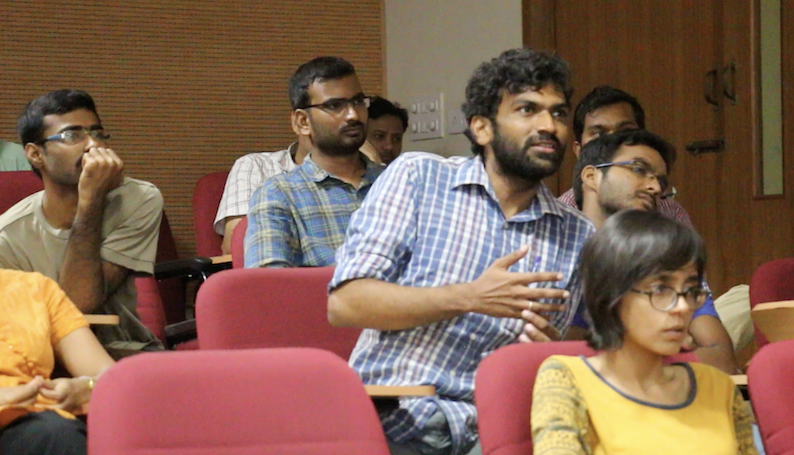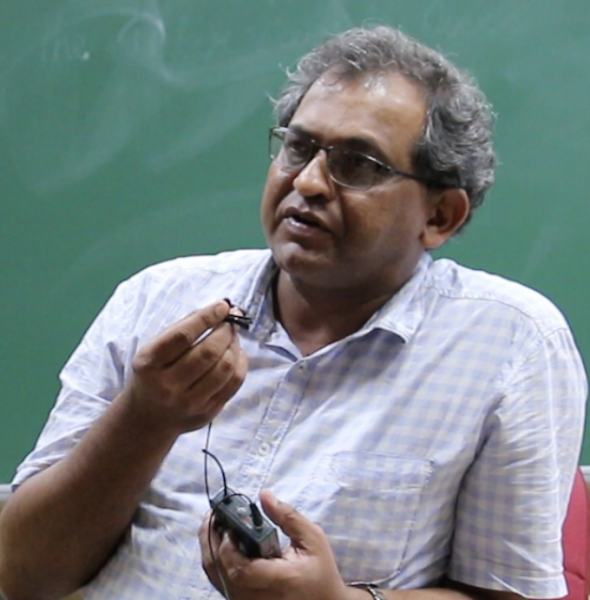Please
Recent Updates
- Public Consultation on Developing a Market Management System for... | Event Announcements | community outreach, projects | 14/11/18
- Some reasons why you shouldn't burn up your Money this Diwali | Other Documents | campaigns | 07/11/18
- Peoples Movements, Networks, Academicians, Researchers and Civil... | Press Releases | campaigns, biodiversity, tree felling, hasiru usiru | 06/11/18
- Following protest, Karnataka Forest Department Cancels Workshop to... | Press Releases | campaigns, biodiversity, tree felling, hasiru usiru | 02/11/18
- A Review of Andhra Pradesh's Climate Resilient Zero Budget... | Press Releases | community outreach, campaigns, biodiversity, publications, brinjal | 18/10/18
"Beerappa's Tallanna" screened at Indian Institute of Science following earlier screenings at National Institute for Advanced Studies, ICTS and ATREE
A film conceptualised by Bhargavi S. Rao and Leo F. Saldanha for Amrit Mahal Hitarakshana aagu Horata Samithi
Phi Delta Alpha (PDA), Indian Institute of Science, Bangalore, organised a screening of "Beerappa's Angst" on 23rd May 2018, at Indian Institute of Science. This was followed by a discussion with Leo Saldanha of Environment Support Group on what the scientific community could do to correct the grave injustices committed by the Insititute in taking 1500 acres of Challakere's ecologically rich Amrit Mahal Kavals, causing widespread displacement, and yet not using any of the land for any productive purpose, a decade after the Karnataka Government allocated the land to the institute and others in building India's "science city".



~~~~~~~~~~~~~~~~~~~~~~~
Watch a recent video story made by The News Minute on
Earlier screenings:
“Beerappa’s Angst” a documentary conceptualized by Bhargavi S. Rao and Leo F. Saldanha on the impact of the 'science city' being promoted at Challakere, Chitradurga, Karnataka, was screened at National Institute for Advanced Studies, Bangalore on 7th March 2018 to a packed hall. The screening was hosted by Dr. Hemangini Gupta and Dr. Carol Upadhya of NIAS. Dr. Suvrat Raju, physicist from International Centre for Theoretical Studies and Prof. Sabyasachi Mukherjee of Indian Institute of Astrophysics responded to the film.
This was then followed by a discussion in which Prof. Jagdish Reddy of Dept of Aerospace Engineering of Indian Institute of Science admitted he was responsible for promoting the 'science city' at Challakere, Chitradurga, and staunchly defended his decision to locate the projects in the biodiversity rich heritage Amrit Mahal Kavals. When challenged to defend the rationality of this decision, with extensive evidence of widespread environmental and social impacts, human rights abuse and also gross illegalities, Prof. Reddy conceded he was wrong in his assumptions and admitted the decision to develop the 'science city' in this manner is not right.
Leo Saldanha of Environment Support Group, Vinay Sreenivasa of Alternative Law Forum, Doddaullarthi Karianna of Amrit Mahal Kaval Hitarakshana aagu Horata Samithi, and others, participated in a most engaging and thought provoking discussion that followed the screening of "Beerappa's Angst".
Listen to a voice recording of the discussion that followed here.
Dr. Carol Upadhya and Dr. Hemangini Gupta of NIAS hosted the screening of the film
Prof. Jagdish Reddy of Indian Institute of Science who promoted the military-industrial-nuclear-power complex in Challakere.

The film was also screened at the International Centre for Theoretical Studies, Bangalore on 2nd May 2018
A video recording of the discussion that followed the screening of the film at ICTS is accessible on Youtube.

and at Ashoka Trust for Research in Ecology and Environment, Bangalore on 4th May.
Abstract: This film, conceptualised by Bhargavi S Rao and Leo F. Saldanha, problematises the building of a massive military-industrial-nuclear-complex in Challakere, Chitradurga, 250 kms north of Bangalore, that is displacing over 300,000 people and about 250,000 livestock without public debate. Based on interviews with communities impacted by these ongoing developments, and also extensive evidence gathered in the process of challenging the projects in the National Green Tribunal, the film discusses the environmental and social impacts, and also risk assessments, of building such sensitive facilities in ecologically sensitive and socio-economically supportive Amrit Mahal Kaval grasslands of Challakere.
The film has been produced by Amrit Mahal Kaval Hitarakshana Haagu Horata Samithi.
* * * * * * * *
Earlier accoloades for this film....


"Beerappa's Angst" (Detail at: http://esgindia.org/…/amrit-mahal-kaval-hitarakshana-horata…), a short documentary which Bhargavi Rao and Leo Saldanha conceptualised and helped make, with support from Ashok Maridas and Gopi, for Amrit Mahal Hitarakshana aagu Horata Samithi, was screened on 6th Jan 2018 at Kirloskar Vasundhara Film Festival in Pune and during November 2017 at the Woodpecker International Film Festival at Siri Fort, New Delhi. Details: http://kirloskarvasundharafest.in and http://www.woodpeckerfilmfestival.in.Â
This film was put together with very little money (~Rs. 50000/-) and is an effort to draw attention of the wide public to the precarious situation of the pastoral, nomadic and agrarian communities in-directly displaced due to ongoing diversion of the Amritmahal Kaval Grasslands in Challakere Chitradurga for a massive military-industrial-nuclear-energy complex.
Communities who have protected these biodiversity-rich grassland ecosystems for centuries are being displaced systematically. About 300000 people and their livestock (approx. 250000) are struggling to survive as the Kavals, which are the foundation of their existence, and which they have protected for centuries, is now out of bounds to them. Consequently, there is massive distress of nutritional, socio-economic and water security, and widespread joblessness. The Amrit Mahal Kaval and such other semi-arid grasslands form a habitat critical for the survival of critially endangered Great Indian Bustard, Indian Wolf, Black Buck, etc.
Mainstream media, academia and large sections of civil society is wary about addressing the sufferings and struggles of the 'science city' impacted communities as it is perceived as 'anti-establishment'. We believe it is the responsibility of media, academia and civil society to focus attention on the struggles of these impacted communities, and the consequent destruction of an ecologically rich arid grassland ecosystems. In this manner, the political and adminstrative machinery of the country can be sensitised to the fact that such projects are fraught with risks which are deliberately ignored, as is reflected in the 'science city' project. The film is a small effort in ensuring we all are concerned about addressing these concerns without fear.
Links to stories on this major concern...

